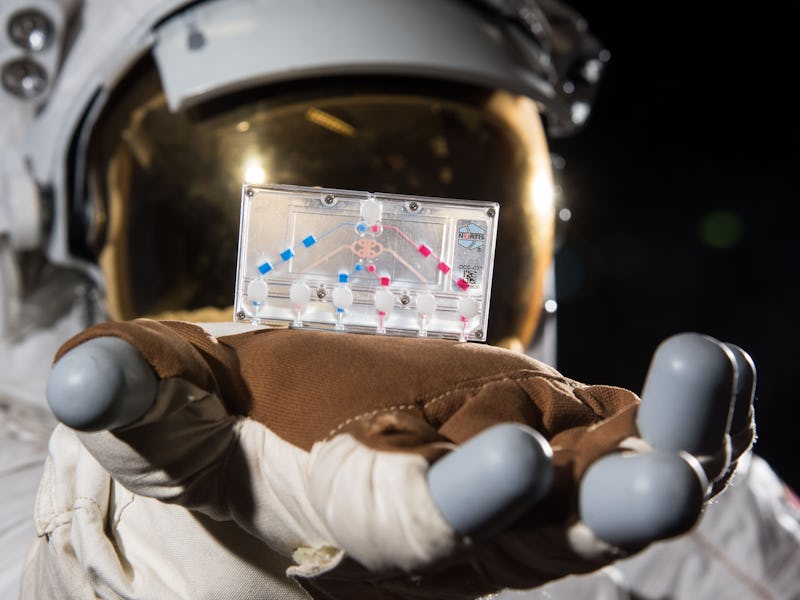When astronauts swim through the microgravity of the International Space Station, their bodies change. Immune systems become confused, while muscles and bones atrophy. These physical changes are akin to aging on Earth, making space ideal for studying the mysteries of aging. But of course, it’s not fair to use astronauts as guinea pigs. Instead, scientists are sending miniature human organs on chips to the ISS as part of SpaceX CRS-17 mission.
The mission, originally scheduled to launch early morning Friday, is now expected to launch at 2:48 am this Saturday.
The project to send human organs to space is called the Tissue Chips in Space Initiative, a collaboration between the National Institutes of Health and the ISS National Lab. The chips themselves, which are somewhere between a microscope slide and a cellphone in size, contain human cells laid out on a scaffold that allows them to mimic the structure and function of organs in the body.
Michael Roberts, Ph.D., is the deputy chief scientist at the ISS National Lab. He tells Inverse that the drive behind this cutting-edge science is to get more treatments to more patients as soon as possible. By observing what happens to the chips when they are space, scientists hope to gain a better understanding of the onset and progression of diseases, especially those linked to aging.
“The space environment has profound effects on humans, and when astronauts experience space for long periods of time, the sort of things that happen to them look a bit like the diseases that are important here on Earth,” Roberts says. “The whole premise of tissue chips is that it enables us to not only better understand how diseases work in the body, but more importantly, it can help us understand what are the best therapeutic agents and medicines that we can use to combat that.”
This week’s launch will be the initiative’s second time sending tissue chips to space since December, when immune system chips were sent to space. Each of the chips that will be launched on Friday to the ISS will model specific tissues: the blood-brain barrier, bone and cartilage, kidneys, and lung and bone marrow. The last one is specifically designed to understand the body’s response to infection: The lung cells will be introduced to a bacterial infection and, in turn, immune system cells on the chip will be evaluated for their effectiveness in stopping that infection.
The plan is for the chips to be sent off to space on Friday from Cape Canaveral, Florida, and after about a day of being berthed to the station, astronauts will transfer them over to their proper place on the ISS. From the perspective of the astronauts working on the experiments, it’ll look like working with aluminum boxes where, inside, the small, thin chips are pumped with fluid and gas.
The human cells will then quickly grow to resemble the function of different organs, and after two weeks, they will be packed up, put into storage, and placed back aboard the SpaceX Dragon capsule. After 40 days, the capsule undocks from the ISS, returns to Earth, and splashes down in the Pacific Ocean.
A tissue chip made of clear flexible plastic.
“A day later, a barge brings the capsule back to Long Beach, California, and scientists can either meet the ship there and get their cells back or have folks send them in the mail,” Roberts explains.
Each tissue project will fly into space twice. The first round is designed to see how the cells change in space, while the second mission revolves around testing potential drug therapies on the biological processes observed in the first mission. For example, whatever accelerated development of osteoarthritis seen in the bone-cartilage chip model will then be treated with novel compounds and drugs when it’s back in space.
Tissue chips, Roberts points out, serve as a quicker and more efficient way to study the body than animal models. They are replicable, so you can test new therapies, and they can be personalized — different cells taken from human donors give scientists the opportunity to learn whether drugs are a once-size-fits all situation or something that needs to be tailored to an individual.
“It’s cutting-edge science,” Roberts says. “For me, it all begins with the excitement of doing good science and utilizing the unique environment of space.”
